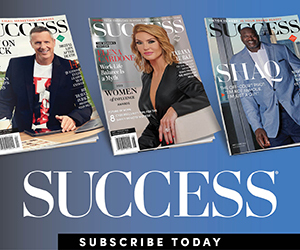Changing and evolving comes with the territory of being alive, but the midlife years often bring an opportunity for more dramatic shifts. For many people, there often comes a point when they realize they are no longer fulfilled or happy with the path they’ve been on.
Dr. Ellen Albertson, psychologist and author of Rock Your Midlife, says that people have this realization for different reasons.
“People start to realize that they are running out of time, and there is less time in front of them than behind them. This can make you feel like many of the goals and dreams you had for yourself may not happen or be possible,” says Albertson.
“There are many changes happening around you. For example, people may experience an empty nest, a health crisis, financial pressures, the death of a loved one, having to be a caregiver to aging parents, feeling irrelevant at work or the career that once lit you up you no longer love. For women, menopause changes the body and brain, which can trigger a big transformation.”
Reassess your life through a midlife edit
What used to be working is no longer working, but what does one do about it? One way to reassess your life is through a “midlife edit”—a period of taking inventory of your life, relationships, careers, goals and priorities—and decide what may need pruning or cultivating.
“It really is this idea of editing things out,” says Neca Smith, a midlife coach who works with women going through career and life transitions. She brings up the example of clothes in the closet that are no longer worn. “When I look at my closet, and when I tell my clients to do this, I say, go look at the things that you never wear. It is a version of yourself that no longer exists.”
The midlife edit involves accepting that the old version of you is gone and making room for the new version of yourself. By letting go of outdated expectations, you can create space to reevaluate your personal and professional paths and embrace a more authentic version of yourself. Smith says, “It is a level of satisfaction that you probably have never felt, because you’re finally stepping into the true version, the real version of yourself.”
Albertson agrees, sharing that the biggest obstacle she sees is people being comfortably uncomfortable.
“It keeps you stuck in reverse doing the same old things and getting the same unsatisfying results,” says Albertson. “Ultimately, what’s keeping people stuck is fear—fear of change, success, failure. People also have a built-in immunity to change, and understanding that can really help.”
Smith explains that there are three stages of going through such a transformative process: The end, the beginning and the exploration.
Acknowledging the end is the beginning of the transformation process
Endings don’t have to be painful, but they should be intentional. Smith says to ask ourselves, “What am I ending?”
When taking inventory of your life, different emotions can rise up. What comes next is an acknowledgment of expectations not met—things we thought would have happened by now but haven’t or things that happened but ended in a way we didn’t expect. While processing the way life has led up to this point, Smith says to take some time to grieve.
“Grieve it,” says Smith. “Grieve and accept what did and did not happen.”
There’s also fear that comes with the ending. Embrace the fear of losing your old identity as an opportunity to discover and redefine who you are. The midlife edit is not about losing yourself to external expectations, but about finding your true essence.
“One fear is, am I going to lose my identity?” says Smith. “And you are to a degree. Because you’re becoming a different version of yourself. It is losing yourself in order to find who you are. But it is a fear of, ‘If I’m not this person, this thing that I’ve always done all of these years, then who am I?’” Smith explains.
From here, Smith says to reframe the question to ask yourself, “Who do I get to be?”
Acknowledge the fears associated with change and take time to grieve and let go of what is no longer serving you. This process is crucial for accepting the past and moving forward with a clearer perspective.
The beginning of a new life
After grieving the end of one type of living, there’s the welcoming of the beginning of a new life. Take time to revisit the goals you set for yourself earlier in life. Identify what truly matters to you now and consider reprioritizing based on your current values and aspirations.
“Revisit your goals,” Smith says. “What were some of the things that you put in place and said that you wanted to do by 50, or you realize isn’t even that important?”
If you never had those set goals, Smith recommends thinking back to your childhood. What did you want to do when you were young?
As you begin again, it’s important to intentionally create quiet time for self-reflection, whether through meditation, mindfulness or prayer. Cultivating your intuition is essential for uncovering your calling and understanding your true desires.
“You really have to be intentional about your quiet time,” says Smith. “So when I say quiet time, for some people, that’s meditating. Some people practice mindfulness, some people pray.”
The exploration of your evolving sense of self
When you’re ready to start a life inventory, take small, intentional steps toward exploring new interests and passions. Be open to trying activities or joining groups that align with your evolving sense of self.
“It’s just about getting out of that comfort zone and trying something new,” says Smith. “And usually, at this age, what I’ve noticed is that you just don’t care as much about what other people think.”
Albertson says it’s also important to remember that no one is actually paying that much attention. “Stop worrying about what others think about you,” she says. “Ditch the ‘expectations’ by showing up as your true, authentic self. No one can tell you that you’re doing it wrong.”
With exploration and change comes a change to relationships too. Communicate openly with friends and family about the transformations you’re experiencing, and be open to exploring new ways of connecting.
“Understand that when you change, that relationship is going to change—and that doesn’t mean it’s going to end right sometimes,” says Smith.
The midlife edit is not a crisis but an opportunity for profound growth, self-discovery and joy. By embracing change, revisiting goals and navigating relationships with openness, people can transform life into an experience they actually enjoy.
Wondering how that might feel? Smith says, “It is freedom. It almost feels like you have scales falling off of you. That’s what I’m envisioning—these scales falling off, and you’re able to just really be free.”
Photo by Kite_rin/Shutterstock.com




